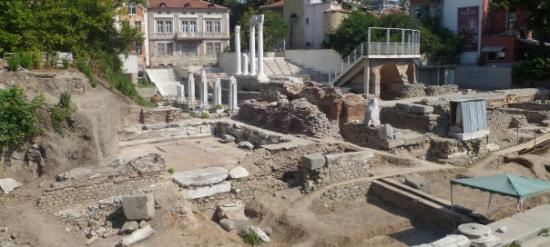Source - http://sofiaglobe.com/2013/06/14/archaeology-bulgarias-2013-season-underway-with-new-discoveries/

The Odeon site, Plovdiv: Clive Leviev-Sawyer
The archaeology season for Bulgaria is underway, with 2013 already seeing new discoveries.
Among these are the finding of a prehistoric sanctuary near the Via Diagonalis Roman road site and a new dating of the Cape Akra, now believed to be from the time of Trojan War.
The projects underway this year include a study of the ancient city of Heraclea Sintica, near the temple of Vanga, the Bulgarian reputed to have been a prophetess. The team carrying out this project includes 12 students from the United States. The Bulgarians in the team include Dr Lyudmil Vagalinski of the National Institute of Archaeology, Dr Sirma Alexandrova, Dr Ivo Tcholakov and the director of the Petrich museum, Sotir Ivanov.
The team worked on the project in July and August 2012 but suspended work because of the heat. The project, a joint one by the Petrich Museum, the American Research Center and the National Architectural Institute, is mainly US-funded. The American partner is the American Research Center in Sofia, represented by Dr. Emil Nankov; sponsorship of the project is provided by ARCS with the support of the America for Bulgaria Foundation.
Among the first tasks of the team were repairs to signs in Bulgarian and English that had been smashed by vandals.
In the past few years, a number of valuable artifacts have been found at the site, some of which are already on display at the Petrich Museum.
Finds date from the period between the fourth century BCE to the fifth century CE. Items found include catapult stones, theatre masks, terracotta figures, a votive plate with the image of Nemesis, arrows and a coin with the image of Roman emperor Marcian Flavius.
The archaeologists working on the site hope that this year they will be able to find the remains of a theatre, a forum and other public buildings.
At the Via Diagonalis site, near Svilengrad, a prehistoric sanctuary was found. The site has, over time, yielded artifacts ranging from the late Neolithic, Bronze Age, Iron Age and the era of the Roman Empire.
The late Neolithic sanctuary site, said to date from 5200 to 4900 BCE, was used for religious rituals and is close to a spring, an important element in ancient beliefs related to fertility and conception, with the water seen as emanating from the Mother Goddess. Rituals dedicated to the Mother Goddess were performed for fertility and protection of the new harvest.
Items found at the site include pottery for ritual meals and other cult objects. Horns of wild and domestic animals were found.
“The deer is a symbol of male potency and burying him in the womb of the Mother Goddess had meaning,” Professor Valentin Nikolov said.
The stretch of the Via Diagonalis being examined is part of the road that linked Central Europe to Constantinople during the Roman and Late Roman era. Archaeologists have traced it as far to four km to the Kapitan Andreevo border checkpoint with Turkey.
On June 10, it emerged that examination of the Cape Akra site was several centuries older than initially had been believed, and it is now seen as dating from the time of the Trojan War.
In April and May, the archaeological team led by Dr Ivan Hristov found pottery of ancient Greek and Roman origin.
Hristov said that the team had found five ritual sites which Thracians may have used to pay tribute or office animal sacrifices to the gods. The discoveries gave a new perspective on the site, earlier seen as dating from the sixth century. Finds of pottery were similar to those found at a Thracian site in the Strandzha area, he said.
In Plovdiv, excavation work at the site next to the central post office is expected to begin in the week starting June 17.
The site is being substantially expanded to the east and north. In 2012, there were a number of significant finds from the layers from the Roman era being exposed.
Archaeologists expect to find a larger portion of a street leading to the western gates of the ancient square. The budget for archaeological work at the central Plovdiv site this year is 400 000 leva, double the funds provided in the 2012 budget.
The city’s mayor, Ivan Totev, told local media that plans continued to be to re-create a link between the Odeon Square and the Forum. This would restore the link that existed between the two about 2000 years ago, and plans were to bring the site up to the standards of the Roman Stadium elsewhere in Plovdiv, which has become a popular tourist drawcard.